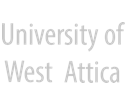Computer-Assisted Translation of Egyptian-Coptic into Greek
Abstract
Purpose - The Coptic language is the final evolutionary stage of Ancient Egyptian, firstly attested in the 1st century CE (Old Coptic) until the 16th century CE, which survives nowadays as the liturgical language of the Coptic Orthodox Church. Egyptian-Coptic had been transliterated through the alphabetization of written Egyptian, based on the Greek script. In this work, the designing of a software tool is presented, for the computer-assisted learning and translation of Egyptian-Coptic into Greek.
Design/methodology/approach - The software design herein emphasizes the ability of processing inscriptions on artifacts through a simple interactive interface for its usage by Greek-speaking scholars of Humanities, having just essential familiarization with computers. For this purpose, a model of processing has been selected, based on an existing software tool for other ancient languages, which is being currently modified for processing Coptic scripts.
Findings - Especially in Greece, several museums and institutions preserve known manuscripts and artifacts of this language and art. Besides the large number of Coptic corpora (gospels and scriptures), a significant and historically important part of texts is found on Coptic artifacts, being difficult to be automatically processed, especially in a Greek context. Considering the above issues, it had been decided in the research project to implement a semi-automated approach, which will allow the user to choose the processed unit, whether this will be smaller, equal or larger than word, following a word-by-word computer-assisted translation into Greek.
Originality/value - Considering the cultural importance of Coptic, they create a continuous of almost 5000 years of written sources in Egyptian language, with an undisputable value in the diachronic history of languages, and prove the unsurpassed cultural relationship between the Ancient Greek and Egyptian civilizations. Therefore, the development of the presented software application aims at further facilitating the Greek-speaking researchers and scholars of Coptic to study this language in depth.
Keywords
References
A. Kontogianni, T. Ganetsos, N. Zacharis, P. Kousoulis, and E. C. Papakitsos, “Α Detailed Study about Egyptian-Coptic and Software Engineering,” Archaeology, vol. 9, no. 1, pp. 28-33, 2021 (Proceedings of the 7th Balkan Symposium on Archaeometry, 22-25 September 2020, University of West Attica, Athens, Greece).
P. J. Allen, “Middle Egyptian: An Introduction to the Language and Culture of Hieroglyphs,” Cambridge University Press, Cambridge, 2000.
P. Kousoulis, “Introduction to Ancient Egyptian Language and Scripture” [in Greek], Association of Greek Academic Libraries, Athens, 2015.
P. J. Allen, “The Ancient Egyptian Language, An Historical Study,” Cambridge University Press, 2013.
A. Robinshon, “Writing and Script: A Very Short Introduction,” Oxford University Press, 2009.
Database and Dictionary of Greek Loanwords in Coptic (DDGLC), available from: https://www.geschkult.fu-berlin.de/en/e/ddglc/index.html
T. G. Wilfong, “Coptic language,” Oxford Classical Dictionary, 2018.
B. Snyder, R. Barzilay, and K. Knight, “A Statistical Model for Lost Language Decipherment,” Proceedings of the 48th Annual Meeting of the Association for Computational Linguistics, Uppsala, pp. 1048-1057, 2010 (available from: https://dl.acm.org/citation.cfm?id=1858788).
D. Pardee, “Ugaritic,” In: R. D. Woodard (editor), “The Ancient Languages of Syria-Palestine and Arabia,” Cambridge University Press, New York (NY), pp. 5-6, 2008.
A. Kontogianni, T. Gkanetsos, and E. C. Papakitsos, “Digitization of Cultural Heritage Works: The Case of Linear B” [in Greek], 3rd Panhellenic Conference on Digitization of Cultural Heritage (EuroMed 2019), University of West Attica, 25-27 September, Egaleo, Greece, 2019.
C. T. Schroeder, H. Behlmer, E. Platte, U. Schmid, A. Zeldes, S. Miyagawa, and F. Feder, “KELLIA Final White Paper,” National Endowment for the Humanities (Grant HG-229371), Deutsche Forschungsgemeinschaft (BE 4172/1-1), 2019 (available from: https://kellia.uni-goettingen.de/downloads/KELLIA-white-paper.pdf).
F. Feder, M. Kupreyev, E. Manning, C.T. Schroeder, and A. Zeldes, “A Linked Coptic Dictionary Online,” Proceedings of the Second Joint SIGHUM Workshop on Computational Linguistics for Cultural Heritage, Social Sciences, Humanities and Literature. Association for Computational Linguistics (Anthology ID: W18-4502), Santa Fe, New Mexico, pp. 12–21, 2018 (available from: https://www.aclweb.org/anthology/W18-4502.pdf).
A. Zeldes, and C. T. Schroeder, “An NLP Pipeline for Coptic,” Proceedings of the 10th ACL SIGHUM Workshop on Language Technology for Cultural Heritage, Social Sciences, and Humanities (LaTeCH2016), Berlin, 2016 (available from: https://doi.org/10.18653/v1/W16-2119).
C. T. Schroeder, and A. Zeldes, “Raiders of the Lost Corpus,” Digital Humanities Quarterly, vol. 10, no. 2, pp. 1-14, 2016 (available from: http://digitalhumanities.org/dhq/vol/10/2/000247/000247.html).
I. Fourtounas, “The Greekness of the Coptic language; Pantainos, the Greek creator of Coptic” [in Greek], Published by the author, Athens, 2012.
E. C. Papakitsos, A. Kontogianni, C. Papamichail, and I. K. Kenanidis, “An Application of Software Engineering for Reading Linear-B Script,” International Journal of Applied Science, Vol. 1, no. 2, pp. 58-67, 2018.
A. Kontogianni, “Research Software: Development of a Linear B Lexicon” [in Greek], Interdisciplinary Joint Postgraduate Course “Technoglossia” (MSc), National & Kapodistrian University of Athens and National Technical University of Athens, 2014.
A. Kontogianni, C. Papamichail, and E. C. Papakitsos, “Educational Software for Learning Linear B” [in Greek], Proceedings of the 9th Conference on Informatics in Education (CIE2017), pp. 423-433, University of Piraeus, Greece, 13th-15th of October, 2017.
A. Mavridaki, E. Galiotou, and E. C. Papakitsos, “Designing a Software Application for the Multilingual Processing of the Linear A Script,” Proceedings of the 24th Pan-Hellenic Conference on Informatics (PCI 2020), Athens, Greece, November 20–22, 2020. ACM, New York, NY, USA, 3 pages. https://doi.org/10.1145/3437120.3437299
DOI: 10.26265/jiim.v5i2.4470
Refbacks
- There are currently no refbacks.






